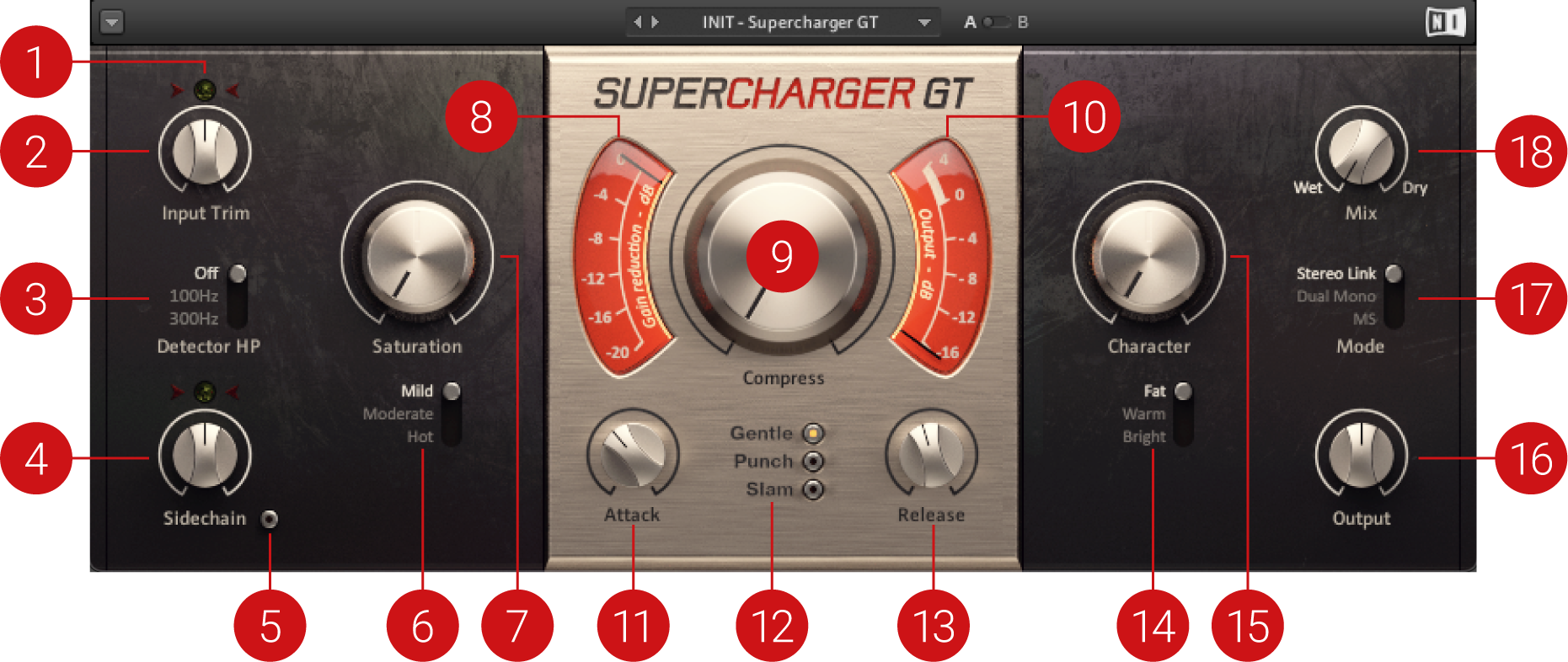Overview
SUPERCHARGER GT's clear but powerful interface enables you to quickly find the right settings whilst providing detail parameters for fine-tuning your sound.
SUPERCHARGER GT's clear but powerful interface enables you to quickly find the right settings whilst providing detail parameters for fine-tuning your sound. The Saturation stage creates rich sounds by adding harmonics. The Attack and Release times can be used to add more bite or sustain to sounds. The Character control colors the sound based on three different modes, Fat, Warm, and Bright. Finally, the Expert Panel provides a filter for the sidechain signal and different stereo routing modes including M/S (mid/side) processing.
SUPERCHARGER GT contains the following parameters and controls:

Input Level Indicator: Displays the input level and indicates the correct setting of the Input Trim control. When the level is set correctly, the center indicator is lit green. When the level is too low, the left arrow indicator is lit red. When the level is too high, the right arrow indicator is lit red.
Input Trim: Adjusts the input level. The correct setting is shown by the Input Level indicator.
Detector HP: Switches between three different settings for a high-pass filter that is applied to the compressor's control signal. Off deactivates the high-pass filter. 100Hz attenuates frequency content below 100 Hz. 300Hz attenuates frequency content below 300 Hz.
Sidechain: Adjusts the level of the sidechain signal, which can be used to control the compressor when the Sidechain switch is activated.
Sidechain switch: Activates the sidechain input, allowing you to use an external signal as the compressor's control signal.
Mild/Moderate/Hot: Switches between three types of saturation. Mild subtly colors the sound. Moderate produces a pronounced saturation effect. Hot adds strong saturation and even distortion to the sound.
Saturation: Adjusts the amount of saturation added to the input signal. The type of saturation can be switched between Mild, Moderate, and Hot.
Gain Reduction Meter: Displays the amount of gain reduction applied to the input signal.
Compress: Adjusts the amount of compression applied to the input signal. Turning the control to the right increases the amount of compression while retaining an even loudness level (as long as Input Trim is set correctly).
Output Level Meter: Displays the level of the output signal.
Attack: Adjusts the attack time, which is the time it takes the compressor to apply the full amount of gain reduction after the control signal rises above the threshold.
Gentle/Punch/Slam: Switches between three distinct preset settings for the Attack and Release. Gentle produces smooth compression suitable for a wide variety of signals. Punch emphasizes transients and performs well on drums. Slam produces intense compression that can be used for drastic effects.
Release: Adjusts the release time, which is the time it takes the compressor to stop applying gain reduction after the control signal falls below the threshold.
Fat/Warm/Bright: Switches between three different types of filtering. Fat emphasizes low-frequency and high-frequency content. Warm reduces high-frequency content and enhances low-frequency content. Bright enhances high-frequency content and reduces low-frequency content.
Character: Adjusts the color of the signal by applying filtering. The type of filtering can be switched between Fat, Warm, and Bright.
Output: Adjusts the output level of the Component.
Mode: Switches between three different stereo routing modes. Stereo Link applies the same amount of gain reduction to both the left and right channels, preserving the original stereo image. Dual Mono applies individual amounts of gain reduction to the left and right stereo channel, increasing loudness in both channels independently. MS applies individual amounts of gain reduction to the mid and the side signal, increasing the width of the stereo image.
Mix: Blends between the effect signal (Wet) and the input signal (Dry). Blending in the input signal can be used to increase dynamics and preserve transients.